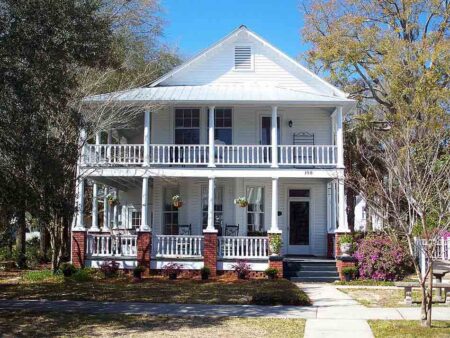River birch is another tree with unusual papery peeling bark. The cultivar ‘Heritage’ is the closest to a paper white birch that will tolerate our hot summers. Expect a river birch to reach 40 to 50 feet in height and 25 to 35 feet in width.
During winter our landscapes take on a new beauty. We’ll take a look at a few plants to consider for winter appeal in North Florida landscapes in today’s article.
Let’s start with the crape myrtle. Gary Knox, University of Florida Extension Horticulture Specialists, describes the crape myrtle’s winter interest perfectly in his publication, “Crape Myrtle in Florida.” Knox writes, “When the leaves fall in winter, the crape myrtle becomes a living sculpture. The trunk and branches of tree-form plants have an attractively gnarled, sinuous character with smooth bark. Strips of bark peel off (exfoliate) in early summer to reveal mottled new bark ranging in color from pale cream to dark cinnamon to rich brown to bright orange.”
Many crape myrtle cultivars have exfoliating bark. The bark begins to peel away with age. With a few years growth, you’ll enjoy crape myrtles that have this characteristic.
Following are some crape myrtles with attractive bark. ‘Acoma’ is an outstanding semi-dwarf hybrid reaching a mature height of around 10 to 15 feet that has creamy beige bark color and snow white flowers. ‘Apalachee’ is another outstanding selection with cinnamon orange bark and light lavender flowers. Its mature height is around 20 feet. The cultivar ‘Osage’ produces dark orange bark and medium pink flowers with a 20-foot mature height. ‘Fantasy’ is a large maturing variety growing to more than 20 feet tall with outstanding red orange bark and white flowers.
River birch is another tree with unusual papery peeling bark. The cultivar ‘Heritage’ is the closest to a paper white birch that will tolerate our hot summers. Expect a river birch to reach 40 to 50 feet in height and 25 to 35 feet in width.
Cultivars of the Ulmus parvifolia, Chinese elm, provide winter interest. “The showy, exfoliating bark reveals random mottled patterns of gray, green, orange and brown, adding great textural and visual interest, especially to its winter silhouette,” writes Ed Gilman, former University of Florida Horticulture Specialist and Researcher. ‘Drake’ and ‘Allee’ are two popular cultivars out of many named varieties of the Chinese elm.
American Hophornbeam, Ostrya virginiana, is an underused tree that grows to about 50 feet in height. Its grayish bark peels off in longitudinal strips revealing orange patches underneath.
Acer buergeranum or trident maple is a very nice small, underused and hard to find tree. It usually is seen with multiple stems originating fairly low on the trunk giving the small tree a bushy appearance. It has noticeable orange-brown peeling bark.
These are a few trees that add winter interest to your landscape. For additional information on trees for Northwest Florida, contact your local Extension Office, County Forester or garden center.
Larry Williams is the Extension horticulture agent with the Okaloosa County Cooperative Extension Service, University of Florida. Contact Larry at 689-5850 or email lwilliams@myokaloosa.com.






